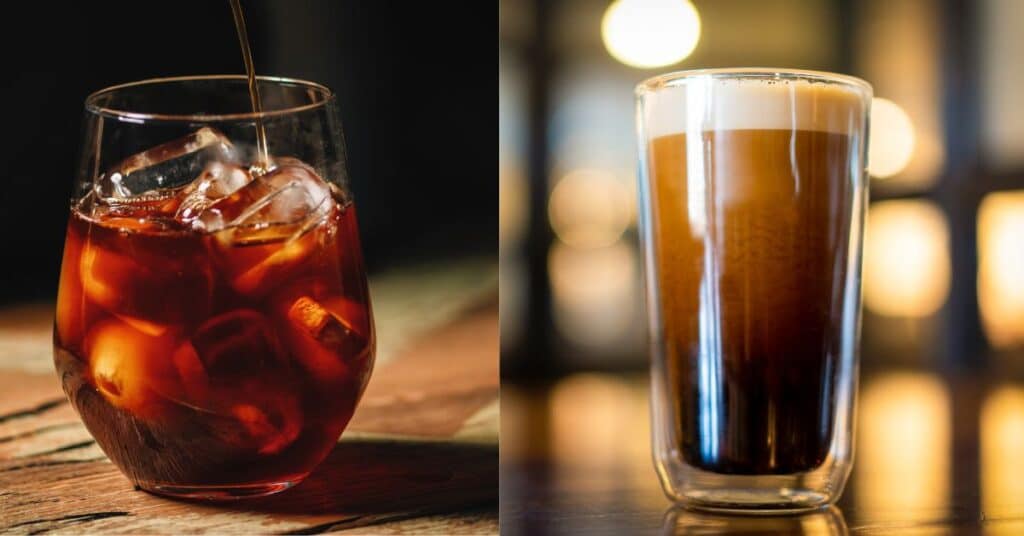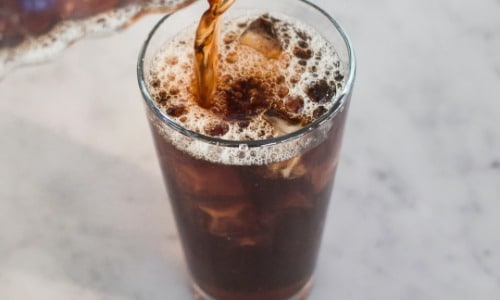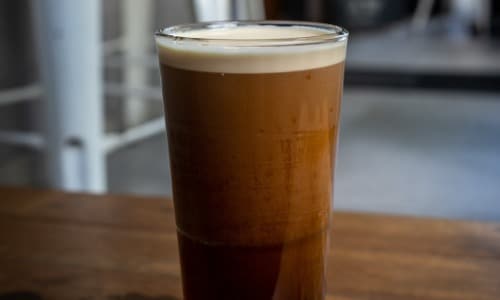
As you stroll into your favorite coffee shop on a warm morning, you’re presented with two intriguing options: cold brew and nitro cold brew. Perhaps you’ve wondered what exactly is the difference between cold brew and nitro cold brew. Both begin with the same fundamental process—steeping coffee grounds in cold water over an extended period—but the nitrogen infusion in nitro cold brew creates a unique experience both in taste and texture.
Cold brew, known for its smooth and acidic-reduced flavor profile, is made by steeping coarsely ground coffee in cold water for 12 to 24 hours. This long extraction time results in a coffee concentrate that’s typically diluted with water or milk and served over ice, offering you a refreshing caffeinated beverage with a full-bodied taste and low bitterness.
Nitro cold brew takes this chilled concoction a step further by infusing it with nitrogen gas through a pressurized valve. This process creates a rich, creamy head similar to that of a stout beer, enhancing the coffee’s natural sweetness. As you watch the cascading effect in a glass of nitro cold brew, you’ll notice it’s typically served without ice to preserve the cascading visual effect and the creamy froth atop.
Cold Brew

Brewing Process
To start creating your own cold brew, you’ll need to steep your coarsely ground coffee beans in cold or room temperature water. This process typically takes about 12 to 24 hours. During this time, the water slowly extracts the flavors from the coffee grounds without the heat that produces the acidity and bitterness found in regular coffee. Once the brewing is complete, you’ll filter out the grounds, leaving a pure, concentrated coffee that can be served chilled.
Flavor Profile
The flavor of cold brew is often described as bold yet smooth with a naturally sweeter and less acidic taste than hot-brewed coffee. Since the extraction process doesn’t involve heat, the resulting brew is usually milder with muted bitterness. You can enjoy this concentrated coffee diluted with water or your favorite milk, which preserves its nuanced flavors without overwhelming its subtleties.
Nitro Cold Brew

Brewing Process
To create Nitro Cold Brew, cold brew coffee is infused with nitrogen under high pressure after the standard cold brewing process, which takes 12 to 24 hours. Once the coffee is steeped and filtered, it’s transferred to a keg or special container where nitrogen is added. The coffee is then served from a tap similar to those used for stouts and porters in bars.
The key steps include:
- Steep: Coarsely ground coffee is steeped in cold, filtered water.
- Filter: After steeping, the coffee concentrate is filtered out of the grounds.
- Nitrogenate: The coffee is infused with nitrogen.
- Serve: The Nitro Cold Brew is typically served from a tap to create a cascading effect.
Flavor Profile
Texture: The infusion of nitrogen gas gives Nitro Cold Brew a creamy, velvety texture that is often compared to that of draught beer.
Taste: Unlike regular cold brew, Nitro Cold Brew has a naturally sweet flavor profile, which is more pronounced due to the nitrogen.
Here’s a simplified flavor comparison:
| Aspect | Nitro Cold Brew | Regular Cold Brew |
|---|---|---|
| Sweetness | Enhanced natural sweetness | Lightly sweet |
| Bitterness | Minimal bitterness | Some bitterness |
| Texture | Smooth, creamy | Silky, but less creamy |
| Refreshment | High due to creamy, cool sensation | High, crisp and energizing |
Brewing Techniques Compared
Time and Temperature
While both cold brew and nitro cold brew are made with cold water, the time they steep varies greatly. Your traditional cold brew is steeped for 12 to 24 hours, creating a smooth and strong concentrate. In contrast, nitro cold brew involves a much shorter interaction with water before it’s infused with nitrogen.
The temperature used is usually room temperature to cold, never hot. This low-temperature steeping prevents the coffee from acquiring a bitter or acidic taste.
Equipment and Methods
The equipment and methods for preparing these beverages differ notably.
For classic cold brew:
- You’ll need a large pitcher or jar and a fine-mesh sieve or a cold brew coffee maker.
- Coarse coffee grounds are immersed in water and left to steep.
Nitro cold brew takes it a step further:
- After brewing, it’s poured into a keg.
- Nitrogen gas is introduced through a pressurized valve, giving it a creamy texture and cascading effect.
Health and Caffeine
When it comes to health and caffeine content, cold brew and nitro cold brew are similar, but they do have key differences. They both start with coffee grounds that steep in cold water for an extended period, typically 12 to 24 hours.
Cold brew is known for being gentler on your stomach due to its lower acidity compared to hot coffee. Nitro cold brew, on the other hand, starts as regular cold brew but is infused with nitrogen gas. This doesn’t significantly change the brew’s health profile, but the creamy texture might make you think it’s richer and more indulgent.
| Aspect | Cold Brew | Nitro Cold Brew |
|---|---|---|
| Caffeine Content | High (varies) | High (varies) |
| Acidity | Lower | Lower |
| Calories | Low (without additives) | Low (without additives) |
| Sugar | None (unless added) | None (unless added) |
| Dairy | None (unless added) | None (unless added) |
The caffeine content in both beverages is typically higher than hot coffee due to the prolonged steeping time, which extracts more caffeine. However, this can vary widely based on the coffee grounds used and the steeping time.
